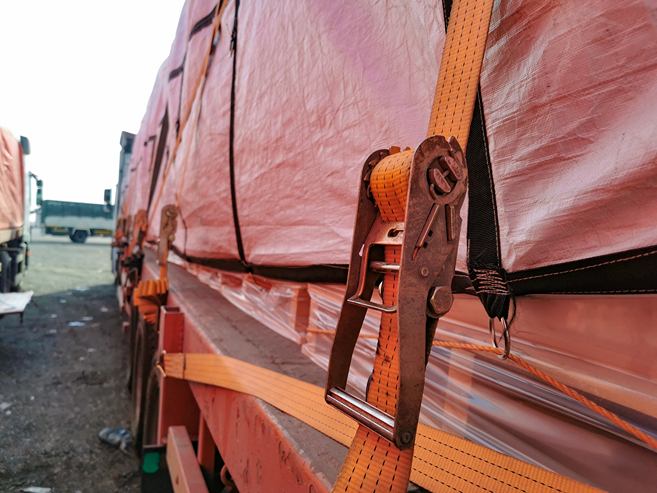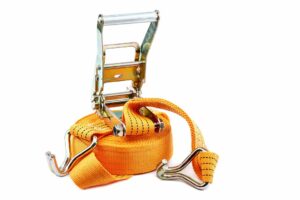
A Comprehensive Guide to Using Ratchet Straps and Releases.

Image: Rachet tie down
Did you know that the first ever ratchet strap was patented in 1853, almost 170 years ago? Made of polyester webbing, ratchet straps have proven to be highly useful tools since then. These are used to wrap materials during transport on a roof-rack or truck bed.
There is a wide variety of ratchet straps available in the market. Each type has different applications. While some are soft and flexible, others have reinforced sides to resist wear and tear. Soft straps are suitable for hauling cargo that requires care, such as furniture and beehives.
How a ratchet is used does not entirely depend on the type. All ratchet straps are used the same way. EZ Connect Floats can guide you in selecting the right ratchet straps as per your needs. To learn more, get in touch with us.
Using ratchet straps properly will help deliver cargo safely. This blog will discuss how to use a ratchet strap and how to release it properly.

How to thread a ratchet strap?
Ratchet straps use a special mechanical ratcheting mechanism to tighten the strap and hold the load in place. Given below are the steps on how to thread a ratchet safely.
- Step 1: Choose the right strap for the job – Before using a ratchet strap, make sure that the strap is designed to manage the weight of the load. Check the length of the strap and the cargo circumference to ensure a safe grip.
- Step 2: Attach the strap to the anchor point – The anchor point can be a trailer, truck, or any other fixed sturdy object that can hold the weight of the load. Thread the end of the strap through the anchor point and back onto itself. Pull the strap tight to ensure that it is secure.
- Step 3: Thread the strap through the ratchet mechanism – Once the strap is attached to the anchor point, thread the loose end of the strap through the ratchet mechanism. Make sure that the strap is flat and not twisted.

Image: How to work a ratchet strap
- Step 4: Tighten the ratchet strap – Use the ratchet handle to tighten the strap. To secure the weight at the right place, ratchet the handle up and down until the strap is taut.
- Step 5: Lock the strap in place – After tightening the strap to the desired level, proceed to secure it by closing the ratchet mechanism. This safety precaution will prevent the strap from becoming loose during transportation.
By following the five easy steps, you can easily use and tighten a ratchet strap. It is always recommended to do it slowly and carefully to avoid any tangles, locks, or accidents.
How to release a ratchet strap
While dealing with transportation of goods, it is equally important to know how to release the ratchet strap properly. An unsafe release can lead to major accidents and damage to humans and materials. Follow the steps below to know about releasing the ratchet strap properly.
- Step 1: Release the handle – To undo the ratchet strap, first pull and hold the release handle. Open it all the way. It will help to loosen the strap.
- Step 2: Pull the strap – Pull the ratchet strap out of the ratchet mandrel through the axle slot.
- Step 3: Close the ratchet – Finally, close the ratchet down and you’re done.
If you’d like to know more about products like straps, reflectors, foams, and floats, go through this piece.

Image: A released ratchet strap
Why choose EZ Connect Floats?
EZ Connect Floats is the go-to brand for all your ratchet needs. Our innovative and user-friendly designs are perfect for securing your loads and equipment during transportation. EZ Connect Floats ratchets are versatile and can be used in automotive, construction, and mechanical applications.
Explore our wide range of products like floats, reflectors, and foam fills.
Key takeaways
Knowing how to use a ratchet strap is essential for people in the logistics and transportation industries. To use a ratchet strap, first attach the hook to the anchor point. Then thread the strap through the ratchet and tighten it by cranking the ratchet handle. To release the strap, push the release lever on the ratchet and pull the strap out.
Be sure to store the strap properly to prevent damage or tangling. Ratchet straps can be used in a variety of situations where you need to secure or tie down items.
If you are already using ratchet straps and are tired of struggling with complicated ones, switch to EZ Connect Floats ratchets. Whether you’re securing a small load or a large piece of equipment, our ratchets are built to last.
Contact us today to learn more about our products and place an order. Our user-friendly designs and high-quality materials are known for securing heavy and bulky items.
Frequently Asked Questions about ratchet straps
1. Why do you use ratchet straps?
Tie-down straps or ratchet straps are greatly useful in transporting cargo in a vehicle. The straps enable you to ensure that the items are secured to a place, such as a truck bed or a roof rack. Usually, while transporting goods on a roof rack or truck bed, these straps are highly effective.
2. Why do ratchet straps have hooks?
The hooks are for tying the ratchet strap to a secure anchor point. These enable the strap to be tightened, effectively securing the cargo. Ratchet straps are commonly equipped with sturdy metal hooks that are specifically designed to conform to diverse anchor points. The hooks and ratchet mechanism allow accurate strap tensioning and fastening.
3. What are the benefits of a ratchet strap?
Ratchet strap helps secure the materials loaded on a truck or other vehicle. The benefits of a ratchet strap include secure and reliable cargo transportation, adjustable tensioning, and efficient loading and unloading processes. Some other benefits are that they are strong, easy to use, reusable, and equally distribute the load.
4. How strong are ratchet straps?
Ratchet straps are capable of a working load limit as high as 5,000 pounds and a 15,000-pound break strength rating. Ratchet straps from EZ Connect Floats ensure high safety and are designed to withstand heavy loads. To increase heavy load carrying capacity, some straps have reinforcing materials in their material of construction.
Have Questions?
Get in touch with us now!
Related Blogs

The Role of Industrial Hose Supply in Workplace Safety and Efficiency
In high-stakes industries such as oil and gas, mining, manufacturing, dredging, and defense, industrial hoses serve as vital connectors in daily operations. Whether transferring hazardous

Common Signs For Dredge Hose Replacement
Dredge hose is an essential component in mining, oil and gas, and heavy industries, where it is used to transport materials such as sediment, slurry,

The Role of Automation and AI in Next-Generation Dredging Technology
Dredging technology has undergone a quiet but powerful transformation over the past decade. A purely mechanical process, which included heavy machinery, manual supervision, and reactive
